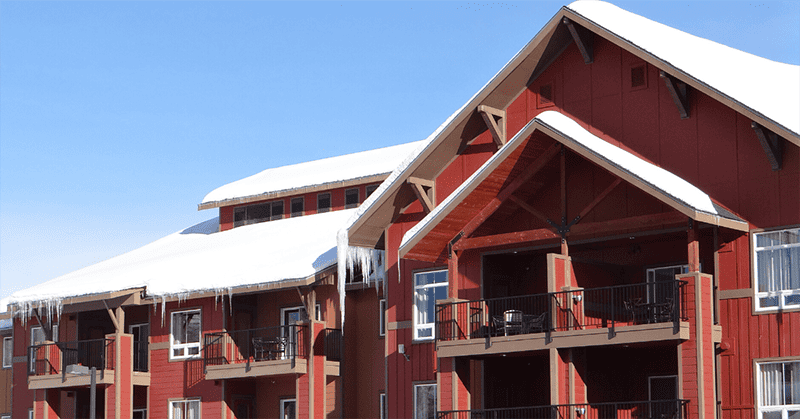A lot goes into choosing a commercial roof; sure, you want it to look attractive and keep the elements out, but there’s a little more to consider. When you’re searching for a commercial roofer near me, take a second to think about the type of roof you want attached to your building. Yes, there are different types of commercial roofs and some are better suited for certain climates than others.
If your winters are freezing and snowfall up to your knees is common, the type of roof is something you don’t want to overlook. Otherwise, your building may have as much snow inside as there is outdoors.

Consider These Factors in Your Roofing Materials
Some materials are better suited for warmer climates, and others work great when the temperature drops. So, what should you consider as you’re contemplating which roofing materials to go with?
Your roof needs insulation; otherwise, your energy bill will take up the majority of your operating costs. The roofing material should also be able to prevent ice dams from forming.
The roof needs to be structurally sound to support the weight of ice and snow.
Watertight materials are key. Eventually, the ice and snow will melt and you don’t want the moisture leaking into your building.
Durable materials are crucial. The roof needs to be strong enough to withstand snow removal tools like shovels. In other words, you don’t want a snow shovel removing a piece of your roof.
The materials need to be able to handle contracting and expanding as the temperature rises and falls.
Don’t forget, your cold climate is going to be hard on your roof. You’ll want to go with one that’s easy to maintain and repair.
Types of Roofing Materials Ideal for Colder Climates
Every type of roofing material has its pros and downsides. Don’t just pay attention to the pros; sometimes, the downsides outweigh any advantages. Making this mistake can be costly, especially in the winter. If your roof goes, you may be shutting down operations until it’s repaired or replaced.
Modified Bitumen Roof
You get flexibility and resistance to extreme temperatures with a modified bitumen roof. With a combination of asphalt and chemical-based polymer, you get great performance regardless of the outdoor temperature. Since the seams are fused together, leaks are rarely a concern. This is great news when snow starts melting in the spring.
Built-Up Roofing (BUR)
If you want to go old-school, a built-up roof will accomplish your goal. With it, you get a multi-layer roof using bitumen and other reinforcing materials.
Yes, this is just as durable as it sounds, which helps explain why this type of roofing system has been around for decades, actually close to a century. You get a nice thick roof that can handle heavy snowfall and keep cold air out of the building.
TPO (Thermoplastic Polyolefin) Roof
Yes, this name is a mouthful, but the single-ply roof is a good option in cold weather. The roof combines a membrane that’s reinforced with polyester.
You may hate polyester clothing, but the material is great for roofing. Polyester isn’t going to become brittle in freezing temperatures and it’s also energy-efficient.
EPDM (Ethylene Propylene Diene Monomer) Roof
You can just refer to this type of roof as EPDM; don’t worry about trying to remember or pronounce its full name. The singly-ply roof is durable and flexible, something you want when snow starts piling up. The flexibility also works to prevent cracking when temperatures rise and fall.
PVC (Polyvinyl Chloride) Roof
PVC roofing systems are also single-ply, like TPO and EPDM. Yes, the acronyms can get confusing, but an experienced roofer can help with the explanations. If you get at least one letter right in the acronym, there’s a good chance they’ll know what you’re talking about.
With a PVC roof, you get excellent durability even when the temperature drops below freezing.
Metal Roofs
While not the best choice in warmer climates, metal roofs are an option when average temperatures stay cool. Metal is also very durable and affordable, and the material is also sturdy enough to support heavy piles of snow.
Green Roofs
No, we don’t mean that your roof isn’t painted green; however, it can be this color if you’d like. Instead, a green roof uses vegetation to provide insulation and help regulate indoor temperatures. A waterproof membrane is laid down before the turf. If sustainability is a key goal, then a green roof may be the way to go.
Contact a Roofing Company to Learn More
Engaging with a roofing company to explore your options is a crucial step, whether you’re aiming to replace an outdated, inefficient roof or seeking methods to align with sustainability goals. This conversation can unveil a range of solutions tailored to your specific needs, potentially revealing innovative materials and technologies that offer enhanced efficiency and environmental benefits.
Moreover, professionals can provide insights into the latest advancements in roofing, such as energy-saving cool roofs or durable, recyclable materials, ensuring your choice not only meets current needs but also contributes to long-term sustainability efforts.
